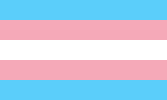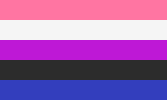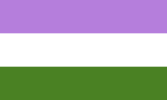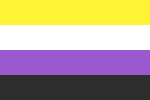Non-binary gender
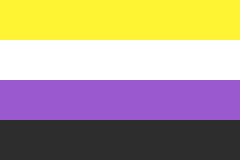 | |
| Classification | Gender identity |
|---|---|
| Abbreviations |
|
| Symbol | |
| Other terms | |
| Synonyms | Genderqueer |
| Associated terms | |
| Part ofa serieson |
| LGBTQ topics |
|---|
|
|
| Part ofa serieson |
| Transgender topics |
|---|
|
|
Non-binary[a]andgenderqueerareumbrella termsforgender identitiesthat are outside the male/femalegender binary.[2][3]Non-binary identities often fall under thetransgenderumbrella since non-binary people typically identify with agenderthat is different from thesex assigned to them at birth,[3]although some non-binary people do not consider themselves transgender.[4][5]
Non-binary people may identify as an intermediate or separatethird gender,[6]identify with more than one gender[7][8]or no gender, or have afluctuating gender identity.[9]Gender identity is separate fromsexualorromantic orientation;[10]non-binary people have various sexual orientations.[11]
Being non-binary is also not the same as beingintersex.Most intersex people identify as either men or women,[12]although some identify as only non-binary, some identify as non-binary and genderfluid, such asHida Viloria,while others identify as non-binary men or non-binary women.
Non-binary people as a group vary in theirgender expressions,and some may reject gender identity altogether.[13]Some non-binary people receivegender-affirming careto reduce the mental distress caused bygender dysphoria,such asgender-affirming surgeryorhormone replacement therapy.[14]
Terms and definitions
The term "genderqueer" first appeared inqueerzinesof the 1980s, preceding the more widely used "non-binary."[15]It gained prominence in the 1990s through activists,[16]such asRiki Anne Wilchins.[17]who used it in a 1995 essay and a 1997 autobiography to describe individuals deviating from traditional gender norms.[18][19]By 2002, the term had further dissemination through the anthologyGenderqueer: Voices Beyond the Sexual Binary.[20]The rise of the internet and public identification by celebrities brought the term "genderqueer" into mainstream awareness during the 2010s.[16]
Genderqueer serves as both an umbrella term for non-binary identities and an adjective describing those who challenge or diverge from conventional gender distinctions, regardless of how they personally identify. It encompasses a range of expressions that transcend the binary gender categories of man and woman.[21][22]
Additionally, being genderqueer is associated withgender ambiguity,[23][page needed]andandrogynous(also "androgyne" ) often used to describe a blend of socially defined masculine and feminine traits.[24][page needed]However, not all genderqueer individuals identify as androgynous; some may identify with traditionally masculine or feminine traits or use alternative descriptors such as "masculine woman" or "feminine man."[25]The term "enby," derived from the acronym NB for non-binary, is also commonly used.[26][27]
The term "transgender"often includes those who are genderqueer or non-binary, reflecting a broad spectrum of gender diversity.[13][28][29]This inclusive usage dates back to at least 1992, with significant contributions from figures such asLeslie Feinberg[16]andKate Bornstein,who emphasized the shared experiences of "gender outlaws."[30]Organizations such as theHuman Rights Campaignand Gender Spectrum use "gender-expansive" to denote a broader range of gender identities and expressions than those typically associated with the binary gender system.[31]
Identities
Agender
Agenderindividuals, also known as genderless, gender-free, non-gendered, or ungendered,[32][33]have no gender at all.[34][35][13]This group represents a spectrum of identities that diverge from conventionalgender norms.According to scholar Finn Enke, not all agender individuals may self-identify as transgender.[36]While there is no universally accepted set of pronouns for agender people,singular theyis commonly used, but it is not the default.[37]Notably, "Agender" and "Neutrois" were among the custom gender options added to Facebook in February 2014 and to OkCupid since November 2014.[38][39]
Multigender/polygender
These terms describe individuals who experience more than one gender identity, either simultaneously or alternately. This category includes identities such as demigender, bigender, pangender, and genderfluid.[40][41]In contrast, those who experience a singular, unchanging gender are referred to as monogender or genderstatic.[42]
Bigender
Bigenderindividuals possess two distinct gender identities which can manifest simultaneously or fluctuate between masculine and feminine expressions.[43][44][45]This differs fromgenderfluididentities, which may not involve fixed gender states but rather a fluid range across the gender spectrum.[46][47]TheAmerican Psychological Associationrecognizes bigender identity as part of the broader transgender category.[48]Surveys and studies, including a 1999 San Francisco Department of Public Health survey and a 2016 Harris poll, have documented the prevalence of bigender identification, particularly within younger generations.[49][50][51]Trigenderpeople shift amongmale,female,andthird gender.[52]
Demigender
Individuals identifying asdemigenderfeel a partial connection to one gender while also identifying with another gender or none at all (agender).[53][54]Subcategories include demi-boy or demi-man, who partially identify as male, and demi-girl, who are partly female and partly non-binary. Demiflux people experience a stable non-binary identity with varying intensities of other gender identities.[54]
Pangender
Pangenderindividuals identify with multiple or all genders, sometimes experiencing all these identities simultaneously.[55][56]
Genderfluid
Genderfluidindividuals do not adhere to a fixed gender identity; their genders change depending on time, place and situation, combining elements from one or more genders at different times.[57][58]This identity can overlap with bigender, trigender, polygender or pangender expressions.[7][8]
Transfeminine or transmasculine
Transfeminine refers to individuals assigned male at birth who predominantly identify or express themselves as feminine. Transmasculine refers to those assigned female at birth who predominantly identify or express themselves as masculine. These terms encompass both binary and non-binary identities.[59]
Two-spirit
Originating from a 1990 Indigenous LGBT gathering in Winnipeg, the termTwo-spiritrefers to individuals within Indigenous North American communities who embody qualities or fulfill roles across traditional gender distinctions.[60]
Xenogender
Xenogenderencompasses a variety of gender identities that are defined using non-traditional concepts often drawn from natural, inanimate, or abstract sources, representing a departure from the typical human gender binary.[61][62]People who identify with a xenogender may not have the words to describe their gender, so instead they compare it to something else.[63]
Other identities
This includes identities such asmaverique,aporagender,ambigender,intergender,andgenderflux,each presenting unique perspectives and experiences outside conventional gender norms.[59]
History


Non-binary gender, often included within the concept ofthird gender,has historical roots that extend well before the modern term was established.[67]For instance, thePublic Universal Friend,who emerged in 1776, was a genderless evangelist who renounced their birth name and gendered pronouns, representing an early instance of non-binary gender expression in America.[68][69][70]
In 1781, Jens Andersson from Norway, assigned female at birth but identifying as male, faced imprisonment and a trial after marrying a woman. When questioned, Andersson stated, "Hand troer at kunde henhøre til begge Deele" ('He believes he belongs to both parts'), indicating a recognition of his dual gender identity.[71]
Judith Butler'sGender Trouble,published in 1990, challenged the fixed male/female binary and advocated for a broader understanding of gender as a spectrum, a view Butler has expanded upon since coming out as non-binary in 2019.[72][73][66][74]
The term "genderqueer" surfaced in the mid-1990s, notably used by activistRiki Wilchinsin the newsletterIn Your Facein 1995, and later in their 1997 autobiography. Wilchins contributed significantly to the discourse, particularly with the 2002 anthologyGenderQueer: Voices from beyond the Sexual Binary.[75][76][77][78]
Jim Sinclair,an autism-rights activist and a founder of Autism Network International, publicly embraced a gender-neutral identity in 1997, declaring a physical and social neuter status in an introduction to theIntersex Society of North America.[79]
InJapan,the expression "X-gender"(x-jendā) has been recognized since the late 1990s, describing a non-binary identity, with notable individuals such as manga artistsYūki KamataniandYuu Wataseidentifying as such.[80][81]
In 2012, the Intersex & Genderqueer Recognition Project began advocating for more inclusive gender options on official documents, a milestone realized whenElisa Rae Shupebecame the first person in the U.S. to obtain official documents with a non-binary gender marker.[82][83]
AlbertalegislatorEstefan Cortes-Vargasopenly identified as non-binary during a 2015 legislative session, marking a significant moment in political recognition of non-binary identities.[84]
Pronouns and titles

Many non-binary people usegender-neutral pronounswith thesingular "they", "their" and "them"being used most commonly in English. Some non-binary individuals opt forneopronounssuch asxe,ze,sie,co,andey.[85][86][87][88]Others may use traditionalgender-specific pronounssuch as "he" or "she", switch between them, or prefer to use their name without pronouns.[89]The titleMx.is also increasingly used as a gender-neutral honorific.[90][91]
A significant 2015 study by the National Center for Transgender Equality surveyed nearly 28,000 transgender people in theUnited States,finding that 35% identified as non-binary or genderqueer. Among them, 84% used pronouns different from those associated with the gender on their birth certificates. The breakdown of preferred pronouns was 37% for "he/him", 37% for "she/her", and 29% for "they/them". Additionally, 20% did not request specific pronouns be used for them, and 4% used pronouns not listed in the survey.[92]
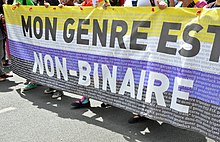
In a 2023 Gender Census survey, 40,375 participants provided insights into how they describe their gender identity and their preferred references. The key identity labels reported were nonbinary, used by 63.1% of respondents (down 0.8% from the previous year), queer (54.8%, up 0.2%), trans (46.7%, up 8.5%), a category described simply as a person/human/[my name]/ "I'm just me" (42.5%, newly included this year), and transgender (40.3%, up 6.4%).[93]The survey also explored title preferences, with 40.1% preferring no title at all (up 1.5%), followed by Mx (18.7%, down 1.4%), Mr (11.5%, up 2.1%), non-gendered professional/academic titles (9.4%, up 1.0%), and Ms (5.5%, up 1.1%). Pronoun usage varied, with "they/them" being the most popular at 74.5% (down 1.2%), "he/him" at 42.5% (up 2.1%), "she/her" at 32.7% (no change), "it/its" at 19.4% (up 3.2%), and a preference for avoiding pronouns or using names as pronouns at 13.2% (up 2.1%). This data offers a comprehensive view of the diverse and evolving ways individuals within the non-binary community identify and prefer to be referred to.[94]
Legal recognition

Many non-binary/genderqueer people use the gender they were given at birth to conduct everyday business, as many institutions and forms of identification—such as passports and driver's licenses—only accept, in the sense of recorded recognition, binary gender identities. But with the increasing acceptance of non-binary gender identities and the rise in wider societal recognition, this is slowly changing, as more governments and institutions recognize and allow non-binary identities.[2]
Multiple countries legally recognize non-binary orthird genderclassifications. Some non-Western societies have long recognized transgender people as a third gender, although this may not (or may only recently)[95]include formal legal recognition. In Western societies, Australia may have been the first country to legally recognize a classification of sex outside of "male" and "female" on legal documentation, with the recognition ofAlex MacFarlane's intersex status in 2003.[96]The wider legal recognition of non-binary people—following the recognition of intersex people in 2003—in Australian law followed between 2010 and 2014, with legal action taken against theNew South Wales GovernmentRegistry of Births, Deaths and Marriages by transgender activistNorrie May-Welbyto recognize Norrie's legal gender identity as "non-specific".India's Supreme Courtformally recognized transgender and non-binary people as a distinct third gender in 2014, following legal action taken by transgender activistLaxmi Narayan Tripathi.[97]In July 2021, Argentina incorporated non-binary gender in its national ID card, becoming the first country in South America to legally recognize non-binary gender on all official documentation; non-binary people in the country will have the option to renew their ID with the letter "X" under gender.[98][99]
While the United States does not federally recognize a non-binary gender, in 2016 Oregon became the first state to recognize a non-binary gender identity.[100]In 2017, California passed an act allowing citizens to identify as "non-binary" on official documents.[100]As of 2019[update],eight states have passed acts that allow "non-binary" or "X" designations on certain identifying documents.[100]One of the main arguments against the inclusion of a third gender identifier in the U.S. is that it would make law enforcement and surveillance harder, but countries that have officially recognized a third gender marker have not reported these issues.[100]In the U.S. there are no explicit laws to protect non-binary people from discrimination, but underTitle VII of the Civil Rights Act of 1964,it is illegal for an employer to require employees to conform togender stereotypes,[101]or to fire them merely for being transgender.[102]
Discrimination
Various countries throughout history have criminalized transgender and non-binary gender identities.[103][104]
In the U.S., 13% of respondents to the 2008National Transgender Discrimination Surveychose "a gender not listed here".[b]The "not listed here" respondents were 9 percentage points more probably to report forgoing healthcare due to fear of discrimination than the general sample (36% compared to 27%). 90 percent reported experiencing anti-trans bias at work, and 43 percent reported having attempted suicide.[105]
The reported discrimination non-binary people face includes disregard, disbelief, condescending interactions, and disrespect.[100]Non-binary people are also often viewed as partaking in a trend and thus deemed insincere or attention-seeking. As an accumulation, erasure is often a significant form of discrimination non-binary people face.[100]
Misgendering,intentional or not, is also a problem that many face. In the case of intentional misgendering,transphobiais a driving force. Additionally, the use ofthey/them pronounsis lumped into[clarification needed]the larger, controversial, subject ofsafe spacesandpolitical correctness,[106]causing pushback and intentional misgendering by some people.[107]
Non-binary and transgender identifying people also face discrimination in sports participation. Non-binary identifying athletes have an immediate barrier as most sports competitions are divided into men's and women's categories.[108]
Healthcare
Nonbinary people may report significantly less well-being and overall health than binary transgender people, although current research demonstrates conflicting perspectives on this topic.[109]These health disparities may be exacerbated byminority stressby breaking gender and social norms.[110][111]
Healthcare professionals are often uninformed about nonbinary people's specific health needs, sometimes requiring nonbinary patients to educate them.[112]Some providers may believe that nonbinary people do not require transition-related treatment,[113]while others may not understand the difference between their identity and the identities of binary transgender patients.[114]Nonbinary patients report lower rates of respect from healthcare providers than binary transgender people.[115]
Transgender health care
Some nonbinary people desiregender-affirming health care,includinghormone replacement therapyorsurgery.[116]Others do not,[117]and the ratio of those who desire care to those who do not is unclear. The factors that lead to this decision are complex and unique to each person.[118]
Nonbinary patients seeking gender-affirming care typically begin treatment earlier than binary transgender patients.[119]
Mental health care
Nonbinary people are likely to face more mental stress than binary transgender people.[92][120]This can be for many reasons including worse mental health and being discouraged from using the bathroom of their choice. According to the Trevor Project, 54% of non-binary and transgender youth have considered suicide and 58% have been discouraged from using the bathroom corresponding to their gender identity.[121]
Symbols and observances

Many flags have been used in non-binary and genderqueer communities to represent various identities. There are distinct non-binary and genderqueer pride flags. The genderqueer pride flag was designed in 2011 by Marilyn Roxie. Lavender represents androgyny or queerness, white represents agender identity, and green represents those whose identities which are defined outside the binary.[124][125][126]The non-binary pride flag was created in 2014 byKye Rowan.[127]Yellow represents people whose gender exists outside the binary, purple represents those whose gender is a mixture of—or between—male and female, black represents people who have no gender, and white represents those who embrace many or all genders.[128]
Genderfluid people, who fall under the genderqueer umbrella, also have their own flag. Pink represents femininity, white represents lack of gender, purple represents mixed gender or androgyny, black represents all other genders, and blue represents masculinity.[125][129]
Agender people, who also sometimes identify as genderqueer, have their own flag. This flag uses black and white stripes to represent an absence of gender, and a green stripe to represent non-binary genders.[130]
International Non-Binary People's Dayis celebrated on July 14.[131][132][133][134]Other observances with non-binary participation includeInternational Transgender Day of Visibility,observed on March 31,[135][136]andInternational Day Against Homophobia, Biphobia, and Transphobia,observed on May 17.[137]
-
Agender pride flag
-
Bigender pride flag
-
Genderfluid pride flag
-
Genderqueer pride flag
-
Trigender pride flag
-
Non-binary gender symbol
-
Agender symbol
-
Genderfluid symbol
Population figures
Argentina
On July 20, 2021, PresidentAlberto Fernándezsigned Decreto 476/2021, mandating that the National Registry of Persons (RENAPER) allow a third gender option on allnational identity cardsandpassports,marked as "X". The measure also applies to non-citizen permanent residents who possess Argentine identity cards.[140]The 2022 national census, carried out less than a year after the resolution was implemented, counted 8,293 (roughly 0.12%) of the country's population identifying with the "X / other" gender marker.[141]
Brazil
A 2021 survey published inScientific Reportsconcluded that 1.19% ofBrazilianadults are non-binary, but the study did not ask whether they self-identified as non-binary. Because the authors considered most Brazilians unfamiliar with North American gender terminology, more open-ended questions about gender were asked.[142][143]
Canada
In April 2022,Statistics Canadareleased findings from the2021 census,making Canada the first country to ask a core question about gender identity, and found that 41,355 Canadians aged 15 and over identified as nonbinary.[144]
A 2019 survey of the two-spirit and LGBTQ+ population inHamilton, Ontario,calledMapping the Void: Two-Spirit and LGBTQ+ Experiences in Hamiltonshowed that 19% of the 906 respondents identified as non-binary.[145]
A 2017 survey of Canadian LGBT+ people calledLGBT+ Realities Surveyfound that 4% of the 1,897 respondents identified as non-binary transgender and 1% identified as non-binary outside of the transgender umbrella.[146]
Switzerland
A 2021 survey found that 0.4% of adults inSwitzerlanddescribe themselves as non-binary.[147]The survey of 2,690 Swiss residents was weighted to be reflective of the entire population.[148]
United Kingdom
According to the2021 United Kingdom census,0.06% of the population in England and Wales identified as non-binary.[149]The proportion was highest among people aged 16 to 24 years (0.26% or 17,000).[150]
United States
According to a 2021 study by theWilliams Institute,an estimated 1.2 million American adults aged between 18 and 60 identify as non-binary, making up 11% of the LGBTQ population in that age bracket.[151]
A 2020 survey byThe Trevor Projectfound that 26% of LGBTQ youth (ages 13–24) in the U.S. identify as non-binary.[5][152]
According toThe Report of the 2015 U.S. Transgender Survey,35% of the nearly 28,000 transgender respondents to the anonymous online survey identified as non-binary.[153][154]
See also
Explanatory notes
References
- ^Bergman, S. Bear; Barker, Meg-John (2017). "Non-binary Activism". In Richards, Christina; Bouman, Walter Pierre; Barker, Meg-John (eds.).Genderqueer and Non-Binary Genders.Critical and Applied Approaches in Sexuality, Gender and Identity.Palgrave Macmillan.p. 43.ISBN978-1-137-51052-5.
- ^abRichards, Christina; Bouman, Walter Pierre; Seal, Leighton; Barker, Meg John; Nieder, Timo O.; T'Sjoen, Guy (2016)."Non-binary or genderqueer genders".International Review of Psychiatry.28(1): 95–102.doi:10.3109/09540261.2015.1106446.hdl:1854/LU-7279758.PMID26753630.S2CID29985722.Archivedfrom the original on June 26, 2019.RetrievedJune 9,2019.
- ^ab"Supporting & Caring for Transgender Children"(PDF).Human Rights Campaign.Archived fromthe original(PDF)on July 24, 2021.RetrievedApril 8,2021.
- ^"Trans + Gender Identity".The Trevor Project.Archivedfrom the original on July 4, 2018.RetrievedOctober 11,2019.
- ^abEnnis, Dawn (July 13, 2021)."New Research Reveals Insights Into America's Nonbinary Youth".Forbes.Archivedfrom the original on January 6, 2022.RetrievedJanuary 6,2022.
- ^Beemyn, Brett Genny (2008)."Genderqueer".glbtq: An Encyclopedia of Gay, Lesbian, Bisexual, Transgender, and Queer Culture.Chicago, Illinois: glbtq, Inc. Archived fromthe originalon April 25, 2012.RetrievedMay 3,2012.[page needed]
- ^abBosson, Jennifer K.; Vandello, Joseph A.; Buckner, Camille E. (2018).The Psychology of Sex and Gender.Thousand Oaks, California: Sage Publications. p. 54.ISBN978-1-5063-3134-8.OCLC1038755742.Archivedfrom the original on May 28, 2020.RetrievedAugust 4,2019– viaGoogle Books.
- ^abWhyte, Stephen; Brooks, Robert C.; Torgler, Benno (September 25, 2018). "Man, Woman," Other ": Factors Associated with Nonbinary Gender Identification".Archives of Sexual Behavior.47(8). Heidelberg, Germany:Springer Science+Business Media:2397–2406.doi:10.1007/s10508-018-1307-3.PMID30255409.S2CID52823167.
2 out of 7479 (0.03 percent) of respondents to the Australian Sex Survey, a 2016 online research survey, self-identified as trigender.
- ^Winter, Claire Ruth (2010).Understanding Transgender Diversity: A Sensible Explanation of Sexual and Gender Identities.Scotts Valley, California: CreateSpace.ISBN978-1-4563-1490-3.OCLC703235508.[page needed]
- ^"Transgender Glossary of Terms".GLAAD Media Reference Guide.Gay & Lesbian Alliance Against Defamation.Archivedfrom the original on May 30, 2012.RetrievedMay 25,2011.
- ^Stryker, Susan(2008).Transgender History.Berkeley, California:Seal Press.ISBN978-1-58005-224-5.OCLC183914566.[page needed]
- ^"Understanding Non-Binary People: How to Be Respectful and Supportive".National Center for Transgender Equality.July 9, 2016.Archivedfrom the original on April 6, 2020.RetrievedJune 17,2020.
- ^abcSchorn, Johanna."Taking the 'Sex' out of Transsexual: Representations of Trans Identities in Popular Media"(PDF).Inter-Disciplinary.Net. Cologne, Germany:University of Cologne.p. 1. Archived fromthe original(PDF)on October 25, 2014.RetrievedOctober 23,2014.
The term transgender is an umbrella term 'and generally refers to any and all kinds of variation from gender norms and expectations' (Stryker 19). Most often, the term transgender is used for someone who feels that the sex assigned to them at birth does not reflect their own gender identity. They may identify as the gender "opposite" to their assigned gender, or they may feel that their gender identity is fluid, or they may reject all gender categorizations and identify as agender or genderqueer.
- ^Hastings, Jennifer (June 17, 2016)."Approach to genderqueer, gender non-conforming, and gender nonbinary people".UCSF Transgender Care.Archivedfrom the original on October 6, 2021.RetrievedOctober 10,2021.
- ^Hendrie, Theo, ed. (2019).X Marks the Spot: An Anthology of Nonbinary Experiences.Independently Published. p. 238.ISBN978-1-0809-6803-9.
- ^abcTobia, Jacob(November 7, 2018)."InQueery: The History of the Word 'Genderqueer' As We Know It".them.Condé Nast.Archivedfrom the original on April 4, 2020.RetrievedFebruary 18,2020.
- ^Wilchins, Riki (March 14, 2017)."Get to Know the New Pronouns: They, Theirs, and Them".Pride.Archivedfrom the original on February 18, 2020.RetrievedFebruary 18,2020.
- ^"Genderqueer History".Archivedfrom the original on November 12, 2018.RetrievedNovember 2,2018.
- ^Wilchins, Riki (Spring 1995)."A Note from your Editrix"(PDF).In Your Face(1): 4.Archived(PDF)from the original on October 5, 2020.RetrievedFebruary 18,2020.
- ^Nestle, Joan; Howell, Clare; Wilchins, Riki Anne, eds. (2002).GenderQueer: voices from beyond the sexual binary(1st ed.). New York City:Alyson Books.ISBN978-1-55583-730-3.OCLC50389309.
- ^Shaw, Susan; Lee, Janet (April 23, 2014).Women's Voices Feminist Visions: Classic and Contemporary Readings(Sixth ed.). New York: McGraw-Hill Education. pp. 130, 135.ISBN978-0-07-802700-0.OCLC862041473.
- ^Dahir, Mubarak (May 25, 1999). "Whose Movement Is It?".The Advocate.San Francisco, California:Here Media.p. 52.
- ^Girshick, Lori B. (2008).Transgender Voices: Beyond Women and Men.Hanover, New Hampshire:University Press of New England.ISBN978-1-58465-645-6.OCLC183162406.
- ^Shaw, Susan M.; Lee, Janet (April 23, 2014).Women's Voices Feminist Visions: Classic and Contemporary Readings(Sixth ed.). New York: McGraw-Hill Education.ISBN978-0-07-802700-0.OCLC862041473.
- ^Walsh, Reuben (December 2010). "More T, vicar? My experiences as a genderqueer person of faith".All God's Children.Vol. 2, no. 3.Lesbian and Gay Christian Movement.
- ^Sheridan, Vanessa (2018).Transgender in the Workplace: The Complete Guide.Bloomsbury Academic. p. 11.ISBN978-1440858062.
- ^Hope, Sam (2019).Person-Centred Counselling for Trans and Gender Diverse People.London, England:Jessica Kingsley Publishers.p. 218.ISBN978-1784509378.
- ^Vargo, Marc E. (November 30, 2011). "A Review ofPlease select your gender: From the invention of hysteria to the democratizing of transgenderism".Journal of GLBT Family Studies.7(5): 2 (493).doi:10.1080/1550428X.2011.623982.ISSN1550-4298.S2CID142815065.
up to three million U. S. citizens regard themselves as transgender, a term referring to those whose gender identities are at odds with their biological sex. The term is an expansive one, however, and may apply to other individuals as well, from the person whose behavior purposely and dramatically diverges from society's traditional male/female roles to the "agender," "bigender" or "third gender" person whose self-definition lies outside of the male/female binary altogether. In short, those counted under this term constitute a wide array of people who do not conform to, and may actively challenge conventional gender norms.
- ^Cronn-Mills, Kirstin (2014)."IV. Trans*spectrum. Identities".Transgender Lives: Complex Stories, Complex Voices.Minneapolis, Minnesota: Twenty-First Century Books. p. 24.ISBN978-1-4677-4796-7.Archivedfrom the original on April 8, 2019.RetrievedOctober 23,2014– viaGoogle Books.
Many different individuals fall under what experts call the trans* spectrum, or the trans* umbrella. "I'm trans*" and "I'm transgender" are ways these individuals might refer to themselves. But there are distinctions among different trans* identities. [...] Androgynous individuals may not identify with either side of the gender binary. Other individuals consider themselves agender, and they may feel they have no gender at all.
- ^Bornstein, Kate (2013).Gender Outlaw: On Men, Women and the Rest of Us.Abingdon, England:Routledge.ISBN978-1-136-60373-0.Archivedfrom the original on March 10, 2021.RetrievedOctober 19,2020– viaGoogle Books.
- ^"Supporting and Caring for our Gender-Expansive Youth"(PDF).Human Rights Campaign.Archived fromthe original(PDF)on January 29, 2016.RetrievedMay 21,2021.
- ^"LGBTQ Needs Assessment"(PDF).Encompass Network.April 2013. pp. 52–53. Archived fromthe original(PDF)on October 24, 2014.RetrievedOctober 18,2014.
- ^"Gender alphabet"(PDF).Safe Homes.p. 1.Archived(PDF)from the original on April 15, 2015.RetrievedOctober 18,2014.
- ^Vargo, Marc E. (2011). "A Review of" Please select your gender: From the invention of hysteria to the democratizing of transgenderism "".Journal of GLBT Family Studies.7(5): 493–494.doi:10.1080/1550428x.2011.623982.S2CID142815065.
- ^Cronn-Mills, Kirstin (2014).Transgender Lives: Complex Stories, Complex Voices.Twenty-First Century Books.ISBN978-1-4677-4796-7.Archivedfrom the original on December 2, 2016.RetrievedFebruary 3,2016– viaGoogle Books.
- ^Anne Enke, ed. (2012). "Note on terms and concepts".Transfeminist Perspectives In and Beyond Transgender and Gender Studies.Temple University Press.pp. 16–20 [18–19].ISBN978-1-4399-0748-1.
- ^Sojwal, Senti (September 16, 2015)."What Does 'Agender' Mean? 6 Things to Know About People With Non-Binary Identities".Bustle.Archivedfrom the original on February 22, 2016.RetrievedFebruary 22,2016.
- ^Sparkes, Matthew (February 14, 2014)."Facebook sex changes: which one of 50 genders are you?".The Daily Telegraph.Archivedfrom the original on May 21, 2018.RetrievedApril 5,2018.
- ^"OkCupid expands gender and sexuality options".PBS NewsHour.November 17, 2014.Archivedfrom the original on November 19, 2014.RetrievedNovember 18,2014.
- ^"Here's What It Means to Be Polygender".Cosmopolitan.January 20, 2022.Archivedfrom the original on March 9, 2024.RetrievedMarch 9,2024.
- ^"What It Means To Be Multigender: The Questions Many Have But Are Afraid To Ask".The Body Is Not An Apology.June 23, 2018. Archived fromthe originalon June 3, 2023.RetrievedMarch 9,2024.
- ^"Gender Fluidity 101".The Everyday.January 17, 2021.Archivedfrom the original on July 19, 2023.RetrievedMarch 9,2024.
- ^Edwards, Ruth Dudley (August 17, 2014)."Asexual, bigender, transexual or cis, can't we all just be kind to each other?".The Independent.Archived fromthe originalon December 18, 2019.RetrievedDecember 18,2019.
- ^Persio, Sofia Lotto (June 16, 2017)."Oregon becomes first state to allow option" X "to end gender binary".Newsweek.Archivedfrom the original on December 18, 2019.RetrievedDecember 18,2019.
- ^"Everything you ever wanted to know about being nonbinary".The Daily Dot.September 28, 2017.Archivedfrom the original on September 28, 2019.RetrievedDecember 18,2019.
- ^"Billy Dee Williams: What is gender fluid?".Monsters and Critics.December 2, 2019.Archivedfrom the original on December 18, 2019.RetrievedDecember 18,2019.
- ^"This is the term for people who aren't exclusively male or female".PinkNews.April 26, 2018.Archivedfrom the original on December 18, 2019.RetrievedDecember 18,2019.
- ^"Sexual orientation and gender identity".Archivedfrom the original on January 2, 2020.RetrievedDecember 18,2019.
- ^Clements, K.San Francisco Department of Public HealthArchivedSeptember 15, 2006, at theWayback Machine,1999
- ^"EEOC now gives nonbinary people a way to be counted in workplace".ThinkProgress.August 20, 2019.Archivedfrom the original on December 18, 2019.RetrievedDecember 18,2019.
- ^"Accelerating Acceptance 2017"(PDF).GLAAD.Archived(PDF)from the original on January 6, 2020.RetrievedDecember 27,2019.
- ^Bosson, Jennifer K.; Vandello, Joseph A.; Buckner, Camille E. (January 17, 2018).The Psychology of Sex and Gender.SAGE Publications.ISBN978-1-5063-3134-8.Archivedfrom the original on August 3, 2021.RetrievedJune 22,2021.
- ^Gibson, Sarah; Fernandez, J. (2018).Gender Diversity and Non-Binary Inclusion in the Workplace: The Essential Guide for Employers.London:Jessica Kingsley Publishers.p. 25.ISBN978-1-78450-523-3.
- ^abBrill, Stephanie; Kenney, Lisa (2016).The Transgender Teen.Berkeley, California:Cleis Press.p. 311.ISBN978-1627781749.
- ^Ginicola, Misty M.; Smith, Cheri; Filmore, Joel M. (February 10, 2017).Affirmative Counseling with LGBTQI+ People.John Wiley & Sons.p. 366.ISBN978-1-119-37549-4.Archivedfrom the original on August 3, 2021.RetrievedJune 22,2021.
- ^"Queer Undefined".Queer Undefined.Archivedfrom the original on January 21, 2021.RetrievedOctober 10,2020.
- ^Cronn-Mills, Kirstin (2015).Transgender Lives: Complex Stories, Complex Voices.Minneapolis, Minnesota: Twenty-First Century Books. p. 24.ISBN978-0-7613-9022-0.
- ^McGuire, Peter (November 9, 2015)."Beyond the binary: what does it mean to be genderfluid?".The Irish Times.Archivedfrom the original on November 22, 2015.RetrievedDecember 1,2015.
- ^abHardell, Ash(2016).The ABC's of LGBT+.Coral Gables, Florida: Mango Media Inc. p. 96.ISBN9781633534094.OCLC962263268.Archivedfrom the original on April 15, 2024.RetrievedApril 15,2024.
- ^de Vries, Kylan Mattias (2009)."Berdache (Two-Spirit)".In O'Brien, Jodi (ed.).Encyclopedia of gender and society.Los Angeles: SAGE. p. 64.ISBN9781412909167.Archivedfrom the original on May 1, 2015.RetrievedMarch 6,2015– viaGoogle Books.
- ^Beattie, Michael; Penny Lenihan; Robin Dundas; Christiane Sanderson (2018).Counselling skills for working with gender diversity and identity.London: Jessica Kingsley Publishers.ISBN978-1-78450-481-6.OCLC1028945173.
- ^Morin, Florentin Félix (April 3, 2017)."EGO HIPPO: the subject as metaphor".Angelaki.22(2): 87–96.doi:10.1080/0969725X.2017.1322822.ISSN0969-725X.S2CID149400086.Archivedfrom the original on March 4, 2022.RetrievedMarch 6,2022.
- ^Nation, LGBTQ (March 2, 2022)."What you need to know about xenogender".LGBTQ Nation.Archivedfrom the original on August 1, 2024.RetrievedAugust 22,2024.
- ^"THE Q LIST Shea Coulee's drag revolution will be televised – Windy City Times News".Windy City Times.January 15, 2014.Archivedfrom the original on January 11, 2023.RetrievedJanuary 11,2023.
- ^"Shea Couleé Opens Up About Embracing Their Non-Binary Identity".Them.May 30, 2019.Archivedfrom the original on February 13, 2023.RetrievedJanuary 11,2023.
- ^abMcManus, Matthew (July 21, 2020)."Matt McManus Interviews Judith Butler".YouTube.Zero Books.37:01.Archivedfrom the original on August 11, 2020.RetrievedJuly 26,2020.
- ^Towle, Evan B; Morgan, Lynn Marie (2002)."Romancing the Transgender Native: Rethinking the Use of the" Third Gender "Concept".GLQ: A Journal of Lesbian and Gay Studies.8(4): 469–497.doi:10.1215/10642684-8-4-469.ISSN1527-9375.S2CID143201735.
- ^Wisbey, Herbert A. Jr. (2009) [1964].Pioneer Prophetess: Jemima Wilkinson, the Publick Universal Friend.Cornell University Press.pp. 7–14.ISBN978-0-8014-7551-1.Archivedfrom the original on June 7, 2020.RetrievedSeptember 8,2021– viaGoogle Books.
- ^Moyer, Paul B. (2015).The Public Universal Friend: Jemima Wilkinson and Religious Enthusiasm in Revolutionary America.Cornell University Press.pp. 12, 18, 100.ISBN978-0-8014-5413-4.
- ^Samantha Schmidt,A genderless prophet drew hundreds of followers long before the age of nonbinary pronounsArchivedDecember 31, 2021, at theWayback Machine,January 5, 2020,The Washington Post
- ^"Et besynderligt givtermaal mellem tvende fruentimmer"[A strange marriage between two women].Skeivt arkiv(in Norwegian). December 16, 2014.Archivedfrom the original on July 27, 2021.RetrievedSeptember 7,2021.
- ^Butler, Judith (1990)."Gender Trouble: Feminism and the Subversion of Identity"(1st ed.). New York: Routledge. p. 149.ISBN0415900433.
- ^Interviews by Kian (December 27, 2019)."Judith Butler on her Philosophy and Current Events".Interviews by Kian.Archived fromthe originalon July 26, 2020.RetrievedJuly 26,2020.
- ^Fischer, Kathryn (July 13, 2020)."Das Pronomen ist frei vom Körper – aber es ist nicht frei vom Geschlecht"[The Pronoun is free from the Body – but it is not free from Gender].Der Tagesspiegel(in German).Archivedfrom the original on March 27, 2023.RetrievedDecember 24,2021.
Welches Pronomen bevorzuge ich? Butler lacht... 'Es ist they', sagt Butler... Wir haben das Jahr 2020 und Butler outet sich als 'they' – ein wahrhaft historischer Moment.
[Which pronoun do I prefer? Butler laughs... 'It is they', Butler says... It is the year 2020, and Butler outs theirself as 'they' – a truly historic moment.] - ^Nestle, Joan; Howell, Clare; Wilchins, Riki Anne, eds. (2002).GenderQueer: voices from beyond the sexual binary(First ed.). Los Angeles: Alyson Books.ISBN1-55583-730-1.OCLC50389309.
- ^Wilchins, Riki Anne (Spring 1995)."In Your Face No. 1 (Spring 1995)".Digital Transgender Archive.Archivedfrom the original on February 17, 2022.RetrievedNovember 22,2022.
- ^"Genderqueer History".Tumblr.Archivedfrom the original on September 13, 2020.RetrievedNovember 22,2022.
- ^Wilchins, Riki (2017).Burn the Binary! Selected Writings on the Politics of Trans, Genderqueer and Nonbinary.Riverdale, NY: Riverdale Avenue Books.ISBN978-1626014077.
- ^"Brief Biography".February 7, 2009. Archived fromthe originalon February 7, 2009.RetrievedNovember 22,2022.
- ^"Intersections: An Introduction to X-Jendā: Examining a new gender identity in Japan".intersections.anu.edu.au.Archived fromthe originalon May 7, 2023.RetrievedNovember 21,2022.
- ^Watase, Yuu [@wataseyuu_](May 20, 2019)."Burogu demo koko demo tsubuyaitakedo, saido. Manga ni mo eikyō shi teru to omoukara. Watashi wa X jendā to ishi ni shindan sa re tete, nakami wa, otoko ni mo on'na ni mo yorerushi otoko demo on'na demonai. Mitame wa chanto (20-dai kōhan kara shakai ni awa sete) dōse yarunara yarude meiku mo oshare mo suru, sore dake. Josei no karada wa hitei shinaiga →"ブログでもここでも呟いたけど, tái độ. Mạn họa にも ảnh hưởng してると tư うから. Tư はXジェンダーと y sư に chẩn đoạn されてて, trung thân は, nam にも nữ にも ký れるし nam でも nữ でもない. Kiến た mục はちゃんと(20 đại hậu bán から xã hội に hợp わせて)どうせやるならやるでメイクもオシャレもする, それだけ. Nữ tính の thân thể は phủ định しないが→[I muttered it on my blog and here, but again. I think it affects comics too. I've been diagnosed as X-gender by a doctor, and I'm neither male nor female. If you want to look good (in your late 20s and in line with society), do it anyway, make up and be fashionable, that's all. I don't deny the female body, but] (Tweet) (in Japanese).RetrievedNovember 21,2022– viaTwitter.
- ^"About Us – Intersex & Genderqueer Recognition Project (IGRP)".igrp.Archivedfrom the original on April 4, 2020.RetrievedDecember 9,2019.
- ^O'Hara, Mary Emily (December 16, 2016)."Movement for third gender option 'exploding' in U.S."NBC News.Archivedfrom the original on October 18, 2019.RetrievedDecember 9,2019.
- ^"An Alberta MLA on battling gender identity".Maclean's,December 1, 2015
- ^"Beyond 'he' and 'she': 1 in 4 LGBTQ youths use nonbinary pronouns, survey finds".NBC News.July 30, 2020.Archivedfrom the original on August 17, 2020.RetrievedMay 20,2024.
- ^Hekanaho, Laura (December 8, 2020).Generic and Nonbinary Pronouns: Usage, Acceptability and Attitudes(PDF)(PhD).University of Helsinki.p. 221.ISBN978-9515168313.Archived(PDF)from the original on March 7, 2021.RetrievedMarch 7,2021.
- ^"Gender Census 2021: Worldwide Report".Gender Census.April 1, 2021.Archivedfrom the original on April 17, 2021.RetrievedApril 16,2021.
- ^Marcus, Ezra (April 8, 2021)."A Guide to Neopronouns".The New York Times.ISSN0362-4331.Archived fromthe originalon December 28, 2021.RetrievedApril 30,2021.
- ^Feinberg, Leslie(1996).Transgender Warriors: Making History from Joan of Arc to Dennis Rodman.Boston, Massachusetts:Beacon Press.ISBN978-0-8070-7940-9.OCLC33014093.
- ^"A gender neutral honorific, 'Mx', could be added to the Oxford English Dictionary very soon".The Independent.May 3, 2015.Archivedfrom the original on November 29, 2022.RetrievedNovember 10,2022.
- ^Pearce, Ruth (July 21, 2011)."Non-gendered titles see increased recognition".Lesbilicious.Archived fromthe originalon September 18, 2019.RetrievedAugust 29,2012.
- ^abJames, S.E.; Herman, J.L.; Rankin, S.; Keisling, M.; Mottet, L.; Anafi, M.The Report of the 2015 U.S. Transgender Survey(PDF).National Center for Transgender Equality.Archived(PDF)from the original on November 25, 2022.RetrievedNovember 25,2022.
- ^Kermode, Jennie (June 13, 2023)."International survey explores changing words for gender".Bylines Scotlant.Archivedfrom the original on June 13, 2024.RetrievedJuly 4,2024.
- ^"Gender Census 2023: Worldwide Report – Gender Census".Archivedfrom the original on September 20, 2023.RetrievedOctober 11,2023.
- ^"Pakistani eunuchs to have distinct gender".BBC News.December 23, 2009.Archivedfrom the original on May 18, 2020.RetrievedDecember 23,2009.
- ^"Newsletter of the Sociology of Sexualities Section of the American Sociological Association"(PDF).American Sociological Association Sexualities News.6(1). Summer 2003.Archived(PDF)from the original on March 4, 2016.RetrievedDecember 9,2013.
- ^McCarthy, Julie (April 15, 2014)."In India, Landmark Ruling Recognizes Transgender Citizens".NPR.Archivedfrom the original on April 30, 2021.RetrievedApril 30,2021.
- ^"Alberto Fernández pone en marcha el DNI para personas no binarias en un paso más por la igualdad de género"[Alberto Fernández launches the DNI for non-binary people in one more step for gender equality].www.clarin.com(in Spanish). July 21, 2021.Archivedfrom the original on July 27, 2021.RetrievedJuly 26,2021.
- ^Westfall, Sammy (July 22, 2021)."Argentina rolls out gender-neutral ID".The Washington Post.Archivedfrom the original on October 3, 2021.RetrievedJuly 27,2021.
- ^abcdef"They, Them, and Theirs".harvardlawreview.org.January 10, 2019.Archivedfrom the original on December 5, 2019.RetrievedDecember 9,2019.
- ^Cecka, Dale Margolin; Chamallas, Martha (2016). "Price Waterhouse v. Hopkins, 490 U.S. 228 (1989)".Feminist Judgments: Rewritten Opinions of the United States Supreme Court.pp. 341–360.doi:10.1017/cbo9781316411254.020.ISBN978-1-107-12662-6.
SeePrice Waterhouse v. Hopkins,490 U.S. 228, 250 (1989 (holding that an employer who punishes employees who fail to conform to stereotypical expectations of members of his or her sex discriminates on the basis of sex).
- ^Liptak, Adam (June 15, 2020)."Civil Rights Law Protects Gay and Transgender Workers, Supreme Court Rules".The New York Times.ISSN0362-4331.Archivedfrom the original on June 17, 2020.RetrievedMarch 7,2022.
- ^Wareham, Jamie."New Report Shows Where It's Illegal To Be Transgender In 2020".Forbes.Archivedfrom the original on April 30, 2021.RetrievedApril 30,2021.
- ^"Trans Legal Mapping Report".ILGA.September 28, 2017.Archivedfrom the original on November 27, 2022.RetrievedJuly 14,2022.
- ^Harrison, Jack; Grant, Jaime; Herman, Jody L."A Gender Not Listed Here: Genderqueers, Gender Rebels, and OtherWise in the National Transgender Discrimination Survey"(PDF).Archived fromthe original(PDF)on July 25, 2012.RetrievedApril 29,2013.
- ^Richards, Christina; Bouman, Walter Pierre; Barker, Meg-John (2017).Genderqueer and Non-Binary Genders.Springer.ISBN978-1-137-51053-2.Archivedfrom the original on March 2, 2021.RetrievedOctober 19,2020.
- ^"Misgendering".California Law Review.Archived fromthe originalon December 22, 2022.RetrievedNovember 11,2022.
- ^Erikainen, Sonja; Vincent, Ben; Hopkins, Al (October 9, 2020)."Specific Detriment: Barriers and Opportunities for Non-Binary Inclusive Sports in Scotland".Journal of Sport & Social Issues.46(1): 75–102.doi:10.1177/0193723520962937.hdl:2164/18985.S2CID225167557.
- ^Price-Feeney, Myeshia; Green, Amy E.; Dorison, Samuel (June 2020)."Understanding the Mental Health of Transgender and Nonbinary Youth".Journal of Adolescent Health.66(6): 684–690.doi:10.1016/j.jadohealth.2019.11.314.ISSN1054-139X.PMID31992489.S2CID210947113.
- ^Burgwal, Aisa; Gvianishvili, Natia; Hård, Vierge; Kata, Julia; García Nieto, Isidro; Orre, Cal; Smiley, Adam; Vidić, Jelena; Motmans, Joz (July 3, 2019)."Health disparities between binary and non binary trans people: A community-driven survey".International Journal of Transgenderism.20(2–3): 218–229.doi:10.1080/15532739.2019.1629370.ISSN1553-2739.PMC6831016.PMID32999608.
- ^Harrison, Jack; Grant, Jaime; Herman, Jody L. (April 1, 2012)."A Gender Not Listed Here: Genderqueers, Gender Rebels, and OtherWise in the National Transgender Discrimination Survey".LGBTQ Public Policy Journal at the Harvard Kennedy School.2(1): 13.Archivedfrom the original on April 21, 2023.RetrievedJune 24,2023.
- ^Kcomt, Luisa; Gorey, Kevin M.; Barrett, Betty Jo; McCabe, Sean Esteban (August 1, 2020)."Healthcare avoidance due to anticipated discrimination among transgender people: A call to create trans-affirmative environments".SSM – Population Health.11:100608.doi:10.1016/j.ssmph.2020.100608.ISSN2352-8273.PMC7276492.PMID32529022.
- ^Vincent, Ben (2020).Non-Binary Genders: Navigating Communities, Identities, and Healthcare.Policy Press.doi:10.56687/9781447351931.ISBN9781447351931.
- ^Taylor, Jessica; Zalewska, Agnieszka; Gates, Jennifer Joan; Millon, Guy (July 3, 2019)."An exploration of the lived experiences of non-binary individuals who have presented at a gender identity clinic in the United Kingdom".International Journal of Transgenderism.20(2–3): 195–204.doi:10.1080/15532739.2018.1445056.ISSN1553-2739.PMC6831017.PMID32999606.
- ^Kattari, Shanna K.; Bakko, Matthew; Hecht, Hillary K.; Kattari, Leonardo (April 1, 2020)."Correlations between healthcare provider interactions and mental health among transgender and nonbinary adults".SSM – Population Health.10:100525.doi:10.1016/j.ssmph.2019.100525.ISSN2352-8273.PMC6909214.PMID31872041.
- ^Beek, Titia F.; Kreukels, Baudewijntje P.C.; Cohen-Kettenis, Peggy T.; Steensma, Thomas D. (November 1, 2015)."Partial Treatment Requests and Underlying Motives of Applicants for Gender Affirming Interventions".The Journal of Sexual Medicine.12(11): 2201–2205.doi:10.1111/jsm.13033.ISSN1743-6109.PMID26553507.Archivedfrom the original on October 1, 2024.RetrievedJune 24,2023.
- ^Burgwal, Aisa; Motmans, Joz (November 2021)."Trans and gender diverse people's experiences and evaluations with general and trans-specific healthcare services: a cross-sectional survey".International Journal of Impotence Research.33(7): 679–686.doi:10.1038/s41443-021-00432-9.hdl:1854/LU-8704468.ISSN1476-5489.PMID33854204.S2CID233225133.Archivedfrom the original on June 24, 2023.RetrievedJune 24,2023.
- ^Vincent, Ben (July 3, 2019)."Breaking down barriers and binaries in trans healthcare: the validation of non-binary people".International Journal of Transgenderism.20(2–3): 132–137.doi:10.1080/15532739.2018.1534075.ISSN1553-2739.PMC6831034.PMID32999601.
- ^Kattari, Shanna K.; Atteberry-Ash, Brittanie; Kinney, M. Killian; Walls, N. Eugene; Kattari, Leonardo (October 21, 2019)."One size does not fit all: differential transgender health experiences".Social Work in Health Care.58(9): 899–917.doi:10.1080/00981389.2019.1677279.ISSN0098-1389.PMID31618117.S2CID204757090.Archivedfrom the original on June 25, 2023.RetrievedJune 25,2023.
- ^Perez-Brumer, Amaya; Day, Jack K.; Russell, Stephen T.; Hatzenbuehler, Mark L. (September 2017)."Prevalence and Correlates of Suicidal Ideation Among Transgender Youth in California: Findings From a Representative, Population-Based Sample of High School Students".Journal of the American Academy of Child & Adolescent Psychiatry.56(9): 739–746.doi:10.1016/j.jaac.2017.06.010.PMC5695881.PMID28838578.
- ^Paley, Amit (2019)."The National Survey on LGBTQ Mental Health"(PDF).The Trevor Project.Archived(PDF)from the original on August 28, 2024.RetrievedAugust 22,2024.
- ^"One Who Fights For an Other".The New Indian Express.Archived fromthe originalon September 24, 2016.RetrievedMay 11,2015.
- ^"Worldwide gay rights as a social movement picks up".merinews.com. Archived fromthe originalon August 2, 2017.RetrievedMay 12,2017.
- ^Deater, Lynn (April 29, 2015)."He, She or They? » The Commuter".ncccommuter.org.Archivedfrom the original on December 21, 2016.RetrievedDecember 20,2016.
- ^ab"Flags and Symbols"(PDF).Amherst, Massachusetts:Amherst College.Archived(PDF)from the original on May 10, 2017.RetrievedDecember 20,2016.
- ^"Gender and Sexuality Awareness Flags".David Mariner.October 26, 2015.Archivedfrom the original on February 3, 2017.RetrievedDecember 20,2016.
- ^"8 Things Non-Binary People Need to Know".Let's Queer Things Up!.March 15, 2015.Archivedfrom the original on December 22, 2016.RetrievedDecember 20,2016.
- ^"After counting up all the 'votes' for each variation of my nonbinary flag (to be separate from the genderqueer flag), it seems this is the most loved! Yay!".genderweird.Tumblr.Archived fromthe originalon June 24, 2018.RetrievedJune 24,2018.
- ^"Gender-fluid added to the Oxford English Dictionary".LGBTQ Nation.Archivedfrom the original on October 25, 2016.RetrievedDecember 20,2016.
- ^Manzella, Samantha (October 7, 2017)."Beyond The Rainbow: Your Guide To LGBT Flags".NewNowNext.Archivedfrom the original on June 25, 2018.RetrievedJune 25,2018.
- ^Mathers, Charlie (July 13, 2018)."Prepare for International Non-binary Day by learning how to be a better ally".Gay Star News.Archivedfrom the original on July 14, 2018.RetrievedJuly 14,2018.
- ^Hirst, Jordan (July 10, 2018)."Inclusive Brisbane Party To Mark International Non-Binary Day".QNEWS Magazine.Archivedfrom the original on July 14, 2018.RetrievedJuly 14,2018.
- ^"Important LGBT Dates".LGBT LifeWestchester.White Plains, NY.Archivedfrom the original on June 26, 2019.RetrievedJune 12,2019.
- ^"International Non-Binary People's Day".Pride Inclusion Programs.acon.Archivedfrom the original on August 3, 2019.RetrievedJune 12,2019.
- ^Fowlkes, A. C."Transgender Day Of Visibility: Honoring The Visible And The Invisible".Forbes.Archivedfrom the original on November 11, 2022.RetrievedNovember 11,2022.
- ^"Opinion | A time to celebrate".The Hamilton Spectator.March 27, 2014.ISSN1189-9417.Archivedfrom the original on April 6, 2020.RetrievedNovember 11,2022.
- ^"Home".May17.org.Archivedfrom the original on March 5, 2023.RetrievedNovember 11,2022.
- ^Gray, Emma; Vagianos, Alanna (July 27, 2017)."We Have A Navy Veteran To Thank For The Transgender Pride Flag".Huffington Post.Archivedfrom the original on September 1, 2018.RetrievedAugust 31,2017.
- ^LB, Branson (July 26, 2017)."The Veteran Who Created The Trans Pride Flag Reacts To Trump's Trans Military Ban".BuzzFeed.Archivedfrom the original on September 1, 2018.RetrievedAugust 31,2018.
- ^"Decreto 476/2021".Boletín Oficial de la República Argentina(in Spanish). July 20, 2021.Archivedfrom the original on July 21, 2021.RetrievedJuly 21,2021.
- ^Censo nacional de población, hogares y viviendas 2022: resultados provisionales(PDF)(in Spanish).Instituto Nacional de Estadística y Censos,INDEC. January 2023. p. 33.ISBN978-950-896-632-2.Archived(PDF)from the original on January 31, 2023.RetrievedJuly 12,2022.
- ^Spizzirri, Giancarlo; Eufrásio, Raí; Lima, Maria Cristina Pereira; de Carvalho Nunes, Hélio Rubens; Kreukels, Baudewijntje P. C.; Steensma, Thomas D.; Abdo, Carmita Helena Najjar (January 26, 2021)."Proportion of people identified as transgender and non-binary gender in Brazil".Scientific Reports.11(1): 2240.doi:10.1038/s41598-021-81411-4.ISSN2045-2322.PMC7838397.PMID33500432.
- ^Sampaio, Jana; Cerqueira, Sofia; de Barros, Duda Monteiro (June 26, 2021)."Nem ele nem ela: os não binários ganham espaço e voz na sociedade".VEJA(in Portuguese).Archivedfrom the original on January 28, 2023.RetrievedJanuary 28,2023.
- ^Easton, Rob (April 27, 2022)."'Historic' census data sheds light on number of trans and non-binary people for first time ".Canadian Broadcasting Corporation.Archivedfrom the original on April 27, 2022.RetrievedApril 28,2022.
- ^"Mapping the Void: Two-Spirit and LGBTQ+ Experiences in Hamilton"(PDF).June 11, 2019.Archived(PDF)from the original on July 3, 2019.RetrievedJuly 19,2019.
- ^"The values, needs and realities of LGBT people in Canada in 2017".2017.Archivedfrom the original on July 27, 2019.RetrievedJuly 27,2019.
- ^"Only 0.4% of Swiss residents describe themselves as non-binary".SWI swissinfo.ch.December 29, 2021.Archivedfrom the original on January 6, 2022.RetrievedJanuary 6,2022.
- ^"Geschlechtergerechter: Studie #1 Geschlecht und Identität"[Gender Equitable: Study #1 Gender and Identity](PDF)(in German). Sotomo. December 2021. p. 5.Archived(PDF)from the original on December 28, 2021.RetrievedJanuary 6,2022.
- ^"Gender identity, England and Wales".Office for National Statistics.Archivedfrom the original on May 19, 2023.RetrievedFebruary 12,2023.
- ^"Gender identity: age and sex, England and Wales - Office for National Statistics".www.ons.gov.uk.Archivedfrom the original on January 2, 2024.RetrievedNovember 4,2023.
- ^Wilson, Bianca D.M.; Meyer, Ilan H. (June 2021)."Nonbinary LGBTQ Adults in the United States".Williams Institute.Archivedfrom the original on June 24, 2021.RetrievedJune 25,2021.
- ^"Diversity of Nonbinary Youth".The Trevor Project.July 13, 2021.Archivedfrom the original on January 6, 2022.RetrievedJanuary 6,2022.
- ^Cummings, William (June 21, 2017)."When asked their sex, some are going with option 'X'".USA Today.Archivedfrom the original on February 4, 2019.RetrievedJanuary 30,2019.
- ^"The Report of the 2015 U.S. Transgender Survey"(PDF).National Center for Transgender Equality.2016. p. 45.Archived(PDF)from the original on May 9, 2018.RetrievedMay 30,2019.
Further reading
- Barker, Meg-John;Scheele, Julia (2016).Queer: A Graphic History.London: Icon Books.ISBN978-1-78578-071-4.OCLC939427299.
- Bernstein Sycamore, Mattilda,ed. (2006).Nobody Passes: Rejecting the Rules of Gender and Conformity.Emeryville:Seal Press.ISBN978-1-58005-184-2.OCLC50389309.
- Bornstein, Kate;Bergman, S. Bear, eds. (2010).Gender Outlaws: The Next Generation(Reprint ed.). Berkeley:Seal Press.ISBN978-1-58005-308-2.OCLC837948378.
- Fine, Cordelia (2011).Delusions of Gender: How Our Minds, Society, and Neurosexism Create Difference(Reprint ed.). New York:W. W. Norton & Company.ISBN978-0-393-34024-2.OCLC449865367.
- Fineman, Martha Albertson (2013)."Feminism, masculinities, and multiple identities".Nevada Law Journal.13(2): 16.Archivedfrom the original on December 11, 2017.RetrievedDecember 11,2017.
- Hines, Melissa (2005).Brain Gender.Oxford University Press.ISBN978-0-19-518836-3.OCLC846105995.
- Nestle, Joan;Howell, Clare;Wilchins, Riki Anne,eds. (2002).GenderQueer: Voices from Beyond the Sexual Binary.Los Angeles:Alyson Books.ISBN978-1-55583-730-3.OCLC50389309.
- Peterson, Tim Trace; Tolbert, T. C., eds. (2013).Troubling the Line: Trans and Genderqueer Poetry and Poetics.Callicoon:Nightboat Books.ISBN978-1-937658-10-6.OCLC839307399.
- Richards, C., Bouman, W. P., & Barker, M.-J. (2017).Genderqueer and non-binary genders.London: Palgrave Macmillan.ISBN978-1-137-51052-5.OCLC1021393997.
- Scout (July 23, 2013)."(A) Male, (B) Female, (C) Both, (D) Neither".The Huffington Post.AOL.Archivedfrom the original on July 27, 2013.RetrievedAugust 2,2013.
- Stryker, Susan;Whittle, Stephen,eds. (2006).The Transgender Studies Reader.New York:Routledge.ISBN978-1-58005-184-2.OCLC50389309.
External links
 The dictionary definition ofnon-binaryat Wiktionary
The dictionary definition ofnon-binaryat Wiktionary Quotations related toNon-binary genderat Wikiquote
Quotations related toNon-binary genderat Wikiquote

